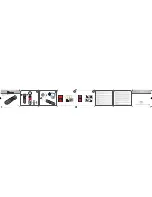
166 /
Care instructions
FOR LeNSeS
• Normally, a soft hair brush is sufficient to remove
dust from the outer lens elements. However, in
case of more stubborn dirt, they can be carefully
cleaned with a very clean, soft cloth that is com
pletely free of foreign matter, using circular motions
from the inside to the outside. we recommend
micro-fiber cloths (available from photographic and
optical specialists) that are stored in a protective
container and can be washed at temperatures of
up to 40°C (without fabric softener, never iron!).
Cloths for cleaning glasses, which are impregnated
with chemicals, should not be used as they can
damage the lens glass.
• Take care not to scratch the 6-bit coding (1.11) in
the bayonet, or to get it dirty. Take care also that no
grains of sand or similar particles enter the fastening,
where they could scratch the bayonet. Never wet
this component when cleaning it!
• For optimum front lens protection in unfavorable
photographic conditions (e.g. sand, salt water
spray), use transparent UVa filters. However, you
should bear in mind that, like all filters, they can
cause unwanted reflections in certain backlight
situations and with high contrasts. The generally
recommended lens hood also protects the lens
from unintentional fingerprints and the rain.
FOR The BATTeRy
rechargeable lithium ion batteries generate power
through internal chemical reactions. These reactions
are also influenced by the external temperature and
humidity. Very high or low temperatures reduce the
life of the battery.
• Always remove the battery if you will not be using
the LeICA M9 for a long period of time. otherwise,
after several weeks the battery could become
totally discharged, i.e. the voltage is significantly
re duced, as the LeICA M9 uses a low noload current
(to save the date) even when it is turned off.
• Lithium ion batteries should be stored only when
partially charged, i.e. not completely discharged or
fully charged (in the corresponding display in the
monitor (1.32)). For very long storage periods, it
should be charged up for around 15 minutes twice
a year to prevent total discharge.
• Always ensure that the battery contacts are clean
and freely accessible. while lithium ion batteries
are proof against short circuits, they should still be
protected against contact with metal objects such
as paper clips or jewelry. A shortcircuited battery
can get very hot and cause severe burns.
• If a battery is dropped, check the casing and the
contacts immediately for any damage. Using a
damaged battery can damage the LeICA M9.
• In case of a smell developing, discoloration, defor
mation, overheating or leaking fluid, the battery
must be removed from the camera or charger
immediately and replaced. Continued use of the
battery carries a risk of overheating, resulting in
fire and/or explosion.
• In case of leaking fluid or a smell of burning, keep
the battery away from sources of heat. Leaked fluid
can catch fire.
• Batteries have only a limited service life.
• Take damaged batteries to a collection point to
ensure correct recycling.
• These batteries may not be exposed to heat, sun
light, humidity or moisture for long periods. Like
wise, the battery may not be placed in a microwave
oven or a high pressure container to prevent a risk
of fire or explosion.
Summary of Contents for L-E
Page 1: ...LEICA M9 M9 P Anleitung Instructions ...
Page 5: ...LEICA M9 M9 P AnLEItung English instructions on pages 90 177 ...
Page 7: ...3 ...
Page 17: ...13 ...
Page 105: ...101 ...
Page 137: ...Bright line view and range finder 133 28 mm 90 mm 50 mm 75 mm 35mm 135 mm ...
Page 183: ...1 33 1 9 1 36 1 35 1 34 1 39 1 37 1 38 1 41 1 40 1 43 1 44 1 42a 1 42 1 45 Signal ...















































